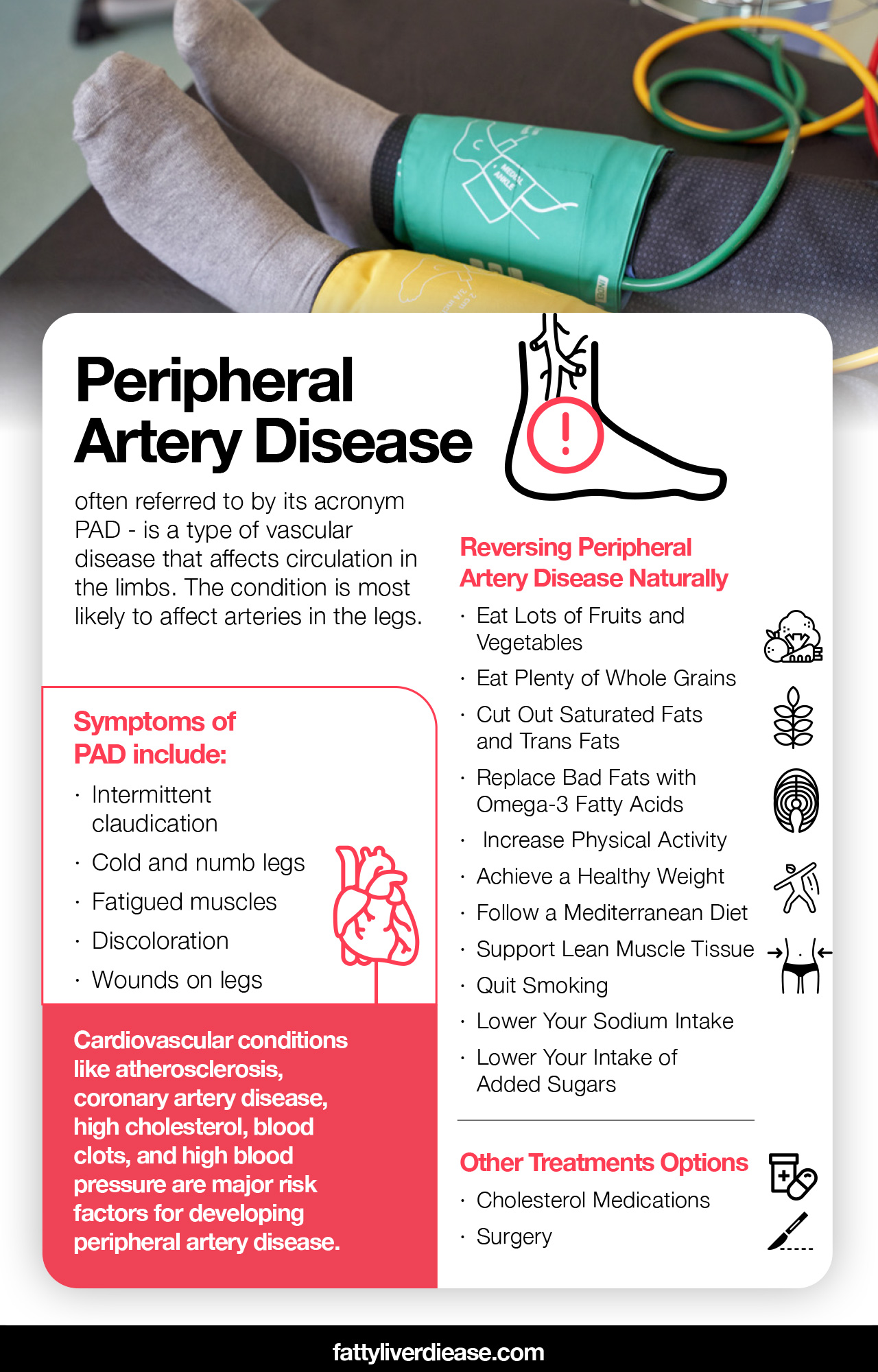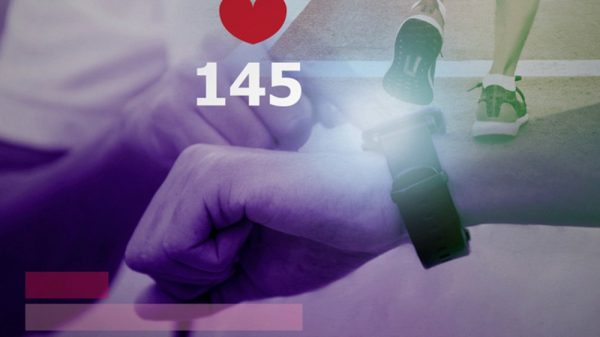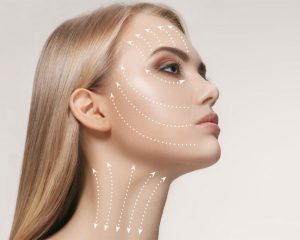Peripheral artery disease is a condition that causes inadequate amounts of blood to reach the legs. If you have been diagnosed with this condition, you may find it tough to stay on your feet for too long and carry out normal day-to-day activities. Peripheral artery disease is linked to cardiovascular conditions, and luckily, there are strategies you can implement at home to help improve your symptoms and reverse the condition.
Keep reading to find out about strategies for reversing peripheral artery disease naturally with diet and lifestyle changes.
What Exactly Is Peripheral Artery Disease?
Peripheral artery disease – often referred to by its acronym PAD – is a type of vascular disease that affects circulation in the limbs. The condition is most likely to affect arteries in the legs. When the extremities aren’t receiving adequate blood flow, they usually begin to hurt and experience other symptoms.
Symptoms of PAD include:
- Intermittent claudication: Claudication describes the type of leg pain that results from limited blood flow, and the pain is often experienced as aching or cramping in the legs. Claudication pain usually comes and goes and most often occurs when you are walking around.
- Cold and numb legs: Without adequate blood flow, your legs will feel cold and numb.
- Fatigued muscles: Inadequate blood flow means the tissues in your legs are not getting the oxygen and nutrients that they need. You may find that when walking, your legs get tired quickly.
- Discoloration: You may notice that the skin on your legs begins to change in color.
- Wounds on legs: You may notice the development of persistent wounds or sores on your legs that take a very long time to heal, or don’t heal at all.
Causes of Peripheral Artery Disease
So, what causes peripheral artery disease? Cardiovascular conditions like atherosclerosis, coronary artery disease, high cholesterol, blood clots, and high blood pressure are major risk factors for developing peripheral artery disease.
Atherosclerosis is a condition that describes the accumulation of cholesterol, triglycerides, and other compounds on the blood vessel walls. These accumulations are called plaques, and if left untreated, they can continue to grow until they severely restrict blood flow in the arteries or cause an entirely blocked artery. A buildup of plaque may also break away from the arterial wall and travel through the bloodstream, where they can get lodged in the heart or brain and cause a heart attack or stroke.
Peripheral artery disease is further exacerbated by high blood pressure. Hypertension means that blood flow exerts too much pressure on the walls of blood vessels. When blood pressure is chronically high, blood vessels become scarred and stiff. The endothelium works less effectively, and the blood vessels are unable to dilate properly to all blood to flow readily throughout the body. Stiff arterial walls combined with atherosclerosis significantly increases the risk of developing peripheral artery disease.
Interestingly, other conditions seem to also be linked to an increased risk of developing peripheral artery disease. Research published in the journal Atherosclerosis found that individuals with liver cirrhosis were at a higher risk of developing peripheral artery disease than individuals without liver cirrhosis. (1)
Finally, family history seems to be linked to an individual’s risk of having peripheral artery disease. If you have a parent or other family member with peripheral artery disease, you may have inherited a genetic predisposition for developing the condition. However, keep in mind that genetics is only part of the story, and many environmental factors can be controlled to minimize your risk or even help resolve peripheral artery conditions.
Reversing Peripheral Artery Disease Naturally
Can PAD be reversed? Peripheral artery disease and associated cardiovascular issues are highly responsive to diet and lifestyle changes, and there are natural remedies that are very effective in the treatment of PAD. Here’s what you can do at home to reverse peripheral artery disease naturally.
1. Eat Lots of Fruits and Vegetables
Incorporating lots of fruits and vegetables into your diet is a crucial dietary PAD treatment strategy. Eating plenty of fruits and vegetables is an important part of improving heart health by lowering cholesterol levels, reducing systemic inflammation, and reducing blood pressure.
Fruits and veggies are packed with antioxidants such as vitamin C, polyphenols, and carotenoids. Eating lots of fresh produce on a daily basis means that these micronutrients are making their way into the bloodstream and damaged blood vessels. Micronutrients help damaged arterial tissue repair themselves, which in turn improves endothelial function. Aim to incorporate a variety of fruits and vegetables into your diet, to make sure you’re getting an array of different antioxidants, vitamins, and minerals. Great examples of heart-healthy
2. Eat Plenty of Whole Grains
Like fruits and vegetables, whole grains are heart-healthy foods that help keep blood pressure low and fight against high cholesterol and atherosclerosis. Whole grains are unprocessed grain products that still contain an outer shell that is intact. Quinoa, brown rice, whole wheat, millet, and oats are excellent types of whole grains to incorporate into your diet.
Whole grains tend to be darker in color, coarser in texture, and nuttier in taste. Before purchasing bread and pasta, always make sure that the packaging specifies that the product is whole-grain. It’s also a good idea to check the ingredients and make sure the product only contains whole grain flour, nuts, and seeds.
3. Cut Out Saturated Fats and Trans Fats
Saturated and trans fat are major contributors to atherosclerosis and heart disease. High consumption of saturated and trans fat is linked to high levels of LDL cholesterol, which is the bad kind of cholesterol that increases the risk of atherosclerosis. Saturated and trans fats are included in many foods that are part of the typical American diet.
Saturated fat is found in abundance in animal products like whole milk, cheese, steak, and bacon. Trans fats are found in abundance in food products such as frozen prepared meals, packaged and preserved foods, and fried foods. Cut these foods out of your diet or save them for very special occasions, in order to help naturally decrease your cholesterol levels and plaque buildup in the arteries.
4. Replace Bad Fats with Omega-3 Fatty Acids
It’s important to keep in mind that not all dietary fats are bad for the heart. In fact, omega-3 fatty acids play a protective role in cardiovascular health. Omega-3 fatty acids are a type of polyunsaturated fat and include three different types: eicosapentaenoic acid (EPA), docosahexaenoic acid (DHA), and alpha-linolenic acid (ALA). All three types seem to protect heart health, though research shows that EPA likely plays the most important role in reducing the risk of cardiovascular disease. (2) An adequate intake of omega-3 fatty acids helps lower inflammation while lowering blood triglyceride levels and reducing the risk of atherosclerosis. (2)
Where can you get omega-3 fatty acids? ALA is present in plant-based foods like flaxseeds, chia seeds, walnuts, pecans, and pumpkin seeds. EPA and DHA are abundant in fatty fish like salmon, mackerel, and sardines.
5. Increase Physical Activity
Regular exercise is extremely important for promoting heart health and arterial health. Aerobic exercise is particularly important for improving the function of your heart and blood vessels. The heart is a muscle, and the more you use it, the healthier it gets.
As you increase your aerobic endurance, the heart muscle gets stronger. When you are at rest, the heart does not need to pump as hard in order to circulate blood throughout the body.
As a result, less force is being exerted on arterial walls, meaning your blood pressure will go down. Lower blood pressure also means that your blood vessels are able to dilate more readily, helping to increase blood flow to the extremities.
If you are new to exercise, beginning a new exercise program may be a daunting task. However, keep in mind that adding gently walking to your routine is a significant step in the right direction. For example, may you start out by walking for 15 minutes around your neighborhood or on the treadmill. As your physical fitness increases, you can gradually ramp up your exercise in both time and intensity.
6. Achieve a Healthy Weight
Obesity has been shown to be connected to heart health. Carrying excess weight has been linked to a number of risk factors that are associated with cardiovascular diseases, such as high cholesterol, high blood pressure, and systemic inflammation. Losing weight is an important part of reversing peripheral artery disease.
What’s the best way to lose weight? You can lose weight by monitoring your calorie intake as well as engaging in regular physical activity. In order to lose weight, it’s important to be in a calorie deficit. Being in a calorie deficit means that you are burning more energy than you consume. In addition, eating a healthy diet is rich in whole foods and plant products can help encourage improved metabolic function and weight loss. Fill your diet with foods like fruits, vegetables, whole grains, beans, nuts, and seeds.
7. Follow a Mediterranean Diet
Following a Mediterranean diet is an excellent strategy for promoting healthy heart function as well as metabolic and liver function. The Mediterranean diet is rich in vegetables, fruit, nuts, seeds, whole grains, low-fat dairy, and fatty fish. When striving to improve heart health and peripheral circulation, it’s helpful to modify the Mediterranean diet to ensure that you eat primarily plant-based foods with regular servings of fatty fish. Eating less dairy may help protect the heart and blood vessels from inflammation.
Fatty fish like mackerel, salmon, and sardines offer omega-3 fatty acids, which reduce systemic inflammation and protect both heart health and metabolic health. Plus, fatty fish is a high-quality protein with optimal ratios of essential amino acids. Strive to eat oily fish at least a couple of times per week.
8. Support Lean Muscle Tissue
Maintaining muscle mass as we get older is a significant determinant of overall metabolic health. Having more muscle mass means that your resting metabolic rate is higher, which may help you more easily achieve a healthy weight. At the same time, having an adequate amount of muscle tissue may help fight heart disease.
A study published in the Journal of Epidemiology and Community Health, researchers analyzed a sample of 1019 people and analyzed skeletal muscle mass and the incidence of cardiovascular disease after 10 years. (3) The findings of the study revealed that having more skeletal muscle mass was associated with a decreased incidence of heart disease for middle-aged adults and older adults. (3)
Moreover, maintaining muscle mass helps to combat the aging process, which is associated with fatigue, weakness, and muscle loss.
When aiming to build muscle, keep in mind that you don’t need to become a bodybuilder! Rather, it’s important to simply challenge your muscles on a regular basis by doing strength training exercises like push-ups and squats. Eating protein that provides optimal ratios of essential amino acids is also crucial for supporting muscle growth and muscle maintenance.
9. Quit Smoking
If you have peripheral artery disease, it’s important to stop smoking. Smoking is associated with a number of cardiac conditions such as high blood pressure and atherosclerosis. Smoking causes construction in the blood vessels, which leads to scarring and high blood pressure. Quitting smoking is an excellent way to reverse hypertension and mitigate many of the symptoms of peripheral artery disease.
Keep in mind that if you are a regular smoker, quitting smoking is no easy task. If you are striving to stop smoking or using tobacco products, talk to a healthcare professional about the best strategies for quitting.
10. Lower Your Sodium Intake
Eating too much salt is associated with high blood pressure. This is because consuming a high-sodium diet causes the body to retain water, in order to ensure that the sodium concentration in the body remains in homeostasis. Along with water retention comes high blood levels, which causes more force to be exerted on arterial walls with each heartbeat.
You can lower the amount of salt you consume by avoiding foods that tend to contain high amounts of sodium. Cheese, preserved meats, canned foods, and packaged foods tend to be high in sodium. Steer clear of frozen meals and restaurant foods, which are usually seasoned with high amounts of salt. Always check the label to ensure that the sodium content is not too high. The American Heart Association recommends that adults should strive to consume a maximum of 1,500 mg of sodium each day. (4)
11. Lower Your Intake of Added Sugars
Consuming too much added sugar is linked to metabolic dysfunction and conditions like insulin resistance, type 2 diabetes, and fatty liver disease. Eating too much added sugar is also linked to weight gain and obesity. When we consume added sugars, the digestive system immediately breaks them down into glucose molecules, which are rapidly absorbed into the bloodstream and spike blood sugar.
Interestingly, consistently consuming high levels of added sugar may worsen high blood pressure. Chronically high levels of blood sugar cause inflammation in the walls of blood vessels, inhibiting their ability to constrict and dilate properly. Subsequent scarring causes the blood vessel walls to become rigid, therefore increasing blood pressure.
You can cut down on your intake of added sugars by avoiding foods like candy, soda, cakes, juice, breakfast cereals, and pastries. Avoiding refined grains is also important for keeping your blood sugar levels stable. Refined grains are rapidly broken down into glucose, which then enters the bloodstream. Steer clear of foods like white rice, white pasta, white bread, crackers, and all foods prepared with white flour.
Other Treatments Options for Peripheral Artery Disease
Though eating a healthy diet and regular exercise may help reverse peripheral artery disease, you may also require treatment.
Cholesterol Medications
PAD patients may benefit from taking medication to help control their cholesterol levels. Your physician may prescribe statins, which is a class of medication that helps keep LDL cholesterol levels low. Lower levels of LDL cholesterol help decrease atherosclerosis and help protect your heart health.
Surgery
Very severe cases of peripheral arterial disease may increase the risk of tissue death, which leads to gangrene. When peripheral arterial disease doesn’t look like it will improve on its own, surgery may be the best option.
A vascular surgeon may perform a bypass surgery in the leg arteries, meaning they reroute blood around the blockages. Alternatively, a vascular surgeon may place stents in legs. A stent is a small tube made of mesh that is designed to hold arteries open, which improves blood flow and prevents atherosclerotic buildup.
Conclusion: Reversing Peripheral Artery Disease Naturally
If you have peripheral artery disease, you are not alone. This painful condition affects middle-aged and older adults at alarming rates. Peripheral artery disease is also connected to heart disease, metabolic conditions, obesity, and liver disease. Moreover, having a family history of peripheral artery disease may increase your risk of developing the condition. Luckily, there are steps you can take at home to reverse peripheral artery disease naturally. Eating an anti-inflammatory plant-based diet that’s rich in whole grains, fruits, veggies, nuts, seeds, and fatty fish can help repair damaged blood vessels. Exercise also helps improve cardiovascular function and fight against peripheral artery disease. These strategies can help mitigate your symptoms and improve arterial function, helping to increase your quality of life.

References:
(1) https://pubmed.ncbi.nlm.nih.gov/29425961/
(2) https://www.uscjournal.com/articles/omega-3-fatty-acids-science























